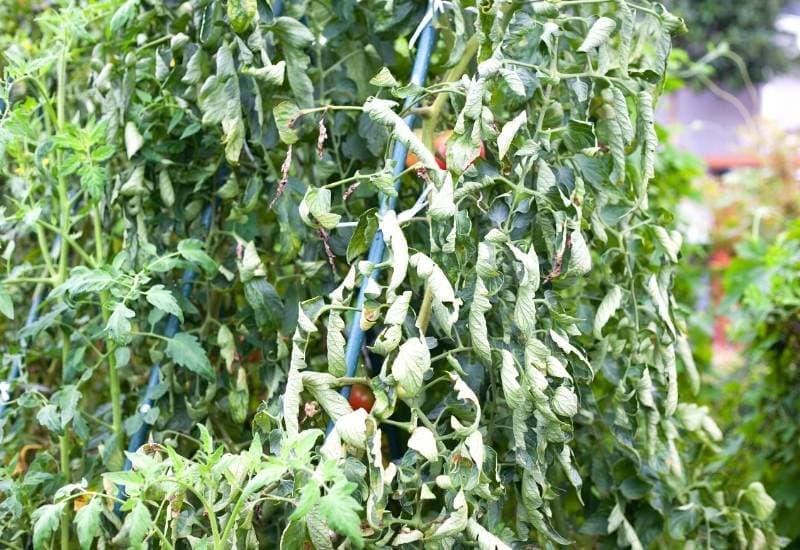
Curling tomato leaves are one of the most common issues tomato gardeners face. The leaves of the tomato plant are sensitive and highly responsive to changing environmental conditions, so curling leaves are often the first sign of an underlying issue that needs to be addressed.
There are multiple reasons why tomato leaves may begin to curl, and if you pay close attention you can see slight variations between different types of leaf curl that will indicate what the root of the issue is.
Once you identify the reasons why your tomato plant leaves are curling up or down you will be better able to effectively treat it or prevent it from happening again in the future.
What Causes Tomato Leaves Twist or Curl?
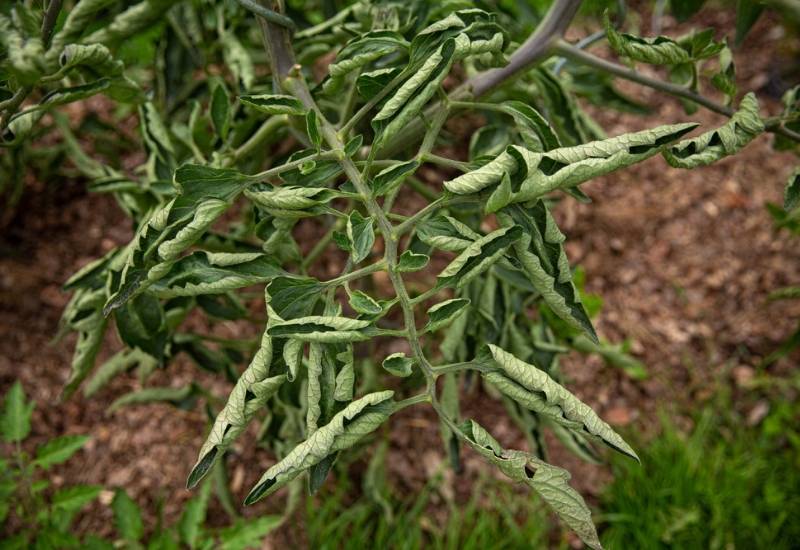
There are a number of reasons why your tomato’s leaves might be curling or rolling, some of which are serious and require immediate attention, and some that are quite treatable.
In short, your tomato leaves could curl from the presence of harmful herbicides, pest invasions, viral infections, or it may be from environmental stress, like wind, heat, water scarcity or flooding.
Let’s explore what each of these issues are in a little more detail:
1: Herbicide Drifting or Residue
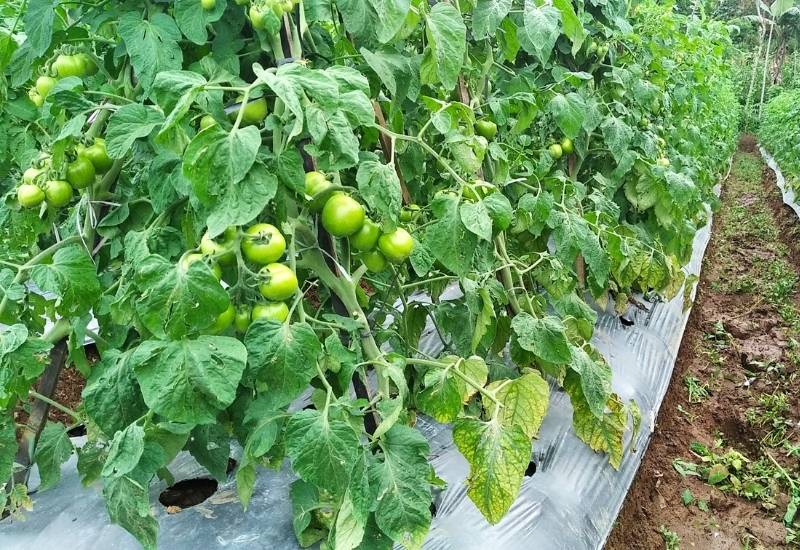
Many herbicides are not designed to be tolerated by tomatoes and other vegetables, but they can still end up in your garden even if you didn’t apply them.
Herbicide drift is when nearby fields or neighbors may be spraying these chemicals and wind carries particles of them over into your property and they land on the leaves of your tomato plant, causing them to curl in response.
Hormonal and glyphosate herbicides are often the culprits, and you might even be doing it to yourself if you use synthetic herbicides on your lawn near your garden.
Similarly, strong herbicides will leave residue in the soil and compost where they were applied, especially ones containing a chemical called aminopyralid.
It is commonly sprayed on hay for cattle, and its harmful residue can be found in cattle dung or compost piles and mulches that have had hay in them.
You could unknowingly have planted your tomatoes in a spot where this chemical is, or applied a mulch or compost that contained it. It will enter the tomato plant through its root system and the leaves will begin to curl and twist as a result.
2: Pest Infestations
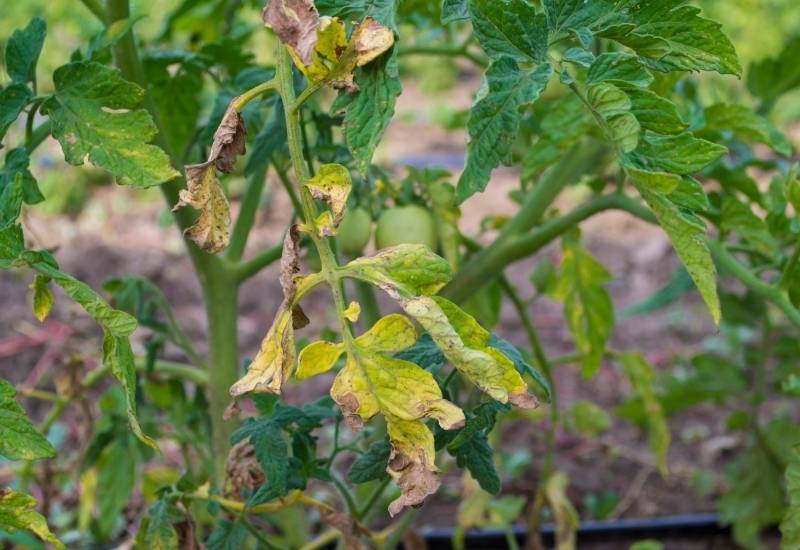
There are a few pests that could potentially create a leaf curling effect in your tomatoes, but the most likely culprit is the Broad mite.
This miniscule mite is not perceptible to the naked eye, so it is often only noticed once the plant starts to show signs of its presence.
The mites will feed on the smaller, younger leaves of the tomato plant, and while feeding they inject a kind of venom into the leaves that causes them to become deformed and twisted. Another sign of the mites is the development of rust colored patches underneath the leaves.
3: Tomato Leaf Curl Viruses
Unfortunately there are a large number of viruses that tomatoes can get, often spread around by pests like the whitefly.
The tomato yellow leaf curl virus is one of the most common viruses that cause a curling effect in the leaves, but tomato leaf crumple, tomato mosaic, chino del tomato, and pepper huasteco viruses are also possible perpetrators.
These all belong to the geminivirus group, which are the viruses most likely to twist or deform the leaves of tomatoes, and can be devastating to the plant.
4: Environmental Stress
Insufficient soil moisture, too high or too low humidity, high winds, flooding, and extreme temperature fluctuations all have the potential to stress the tomato plant and cause the leaves to curl.
Physiological leaf rolling is the name given to curling leaves in response to drought, as they roll inwards to conserve their remaining water stores.
In most cases, leaf curling from environmental factors can be remedied without affecting the overall yield of the tomato plant too severely, if it is identified promptly.
How to Identify the Cause of Curling Leaves On Tomato Plants
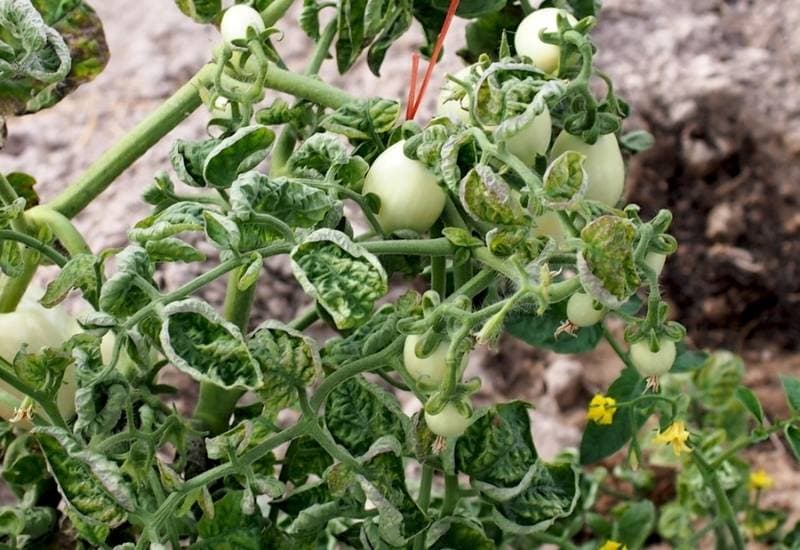
So how can we tell which cause is the culprit? Fortunately, these issues all have slightly different ways that they can be distinguished based on the way in which the leaf is curling.
Inspect your curling leaves and identify the direction and location of the curling, then use this guide to determine what the cause might be.
Keep in mind that these are general guidelines, and some causes may manifest in different curling patterns than those listed here.
1: Tomato Leaves Curling Up
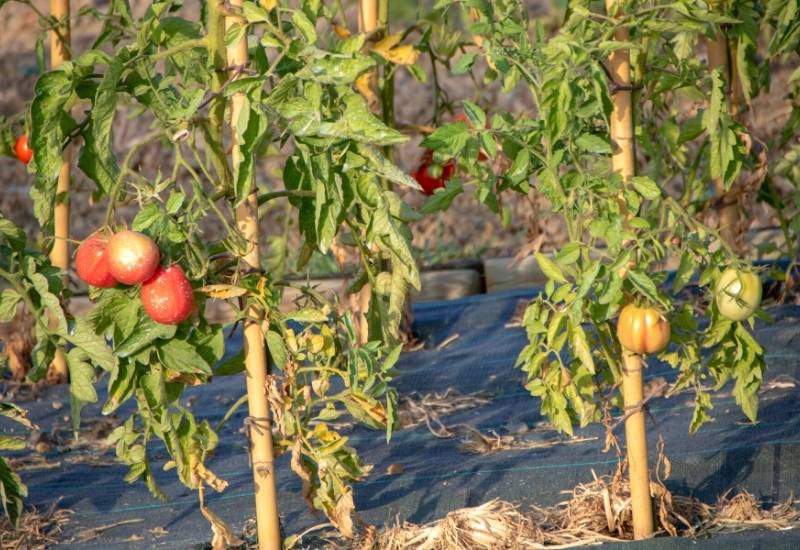
If your tomato leaves are curling upwards, it is likely due to environmental stress, and could be physiological leaf curl and your plant is too hot and dry.
Wind damage on the foliage of your tomato plant will also often create upward curling leaves. Some tomato viruses will cause upward curling, but not consistently.
2: Leaves Of Your Tomato Plants Curling Down
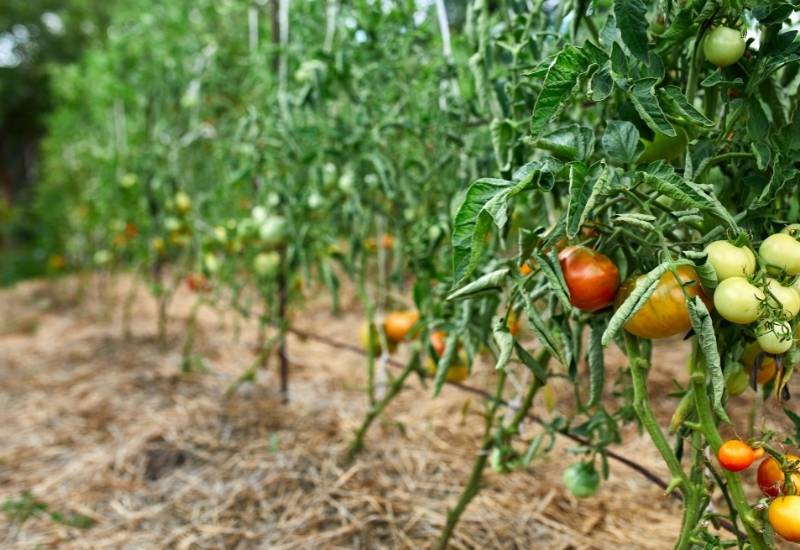
Downward curling leaves of your tomatoes often caused by the presence of herbicide residues in the soil, or herbicide particles that may have blown over from a neighbor treating their lawn or nearby farmed fields.
This was previously not thought to be a significant risk to tomatoes, but with increased spraying of glyphosate herbicides it has become a well-known cause for curling leaves.
3: Curling in Older, Lower Leaves
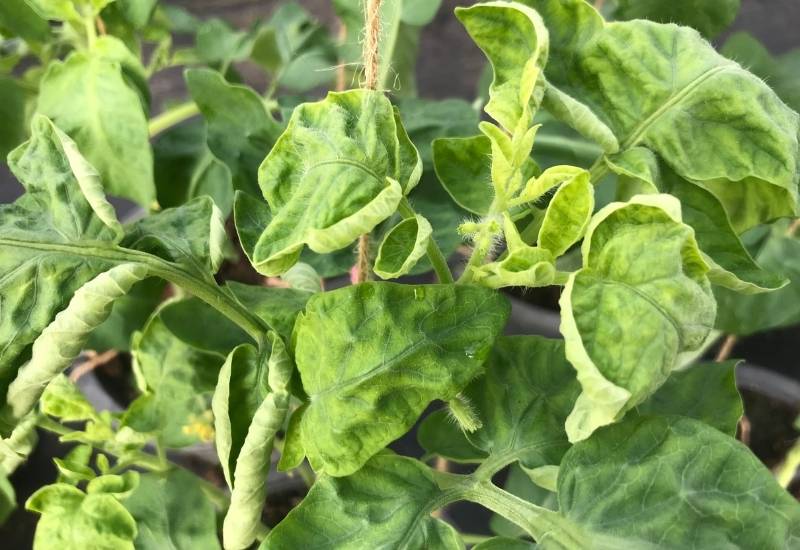
If you are noticing the curling effect is primarily affecting the older leaves at the bottom of the tomato plant, environmental stressors may be the culprit.
Physiological leaf rolling occurs in the oldest leaves of the plant first, before eventually working its way up the plant. Leaves will curl upwards and small leaves may curl inwards.
4: Curling in Younger, Upper Leaves
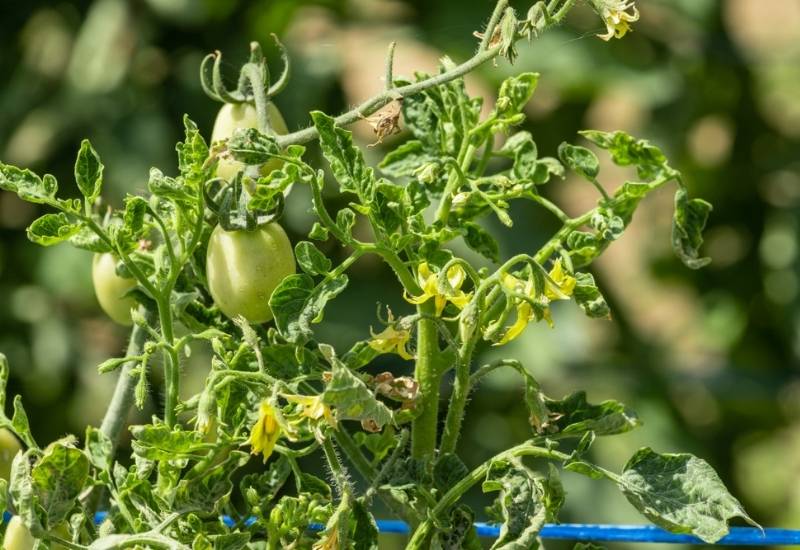
New growth is usually affected first by herbicide presence, some viruses, and broad mites. If the smaller leaves at the top of your tomato plant are curling and they are curling in a downward fashion, it is likely herbicide residue.
If the youngest leaves are curling and there is some rust colored patching underneath them, it is likely to be broad mites.
Viruses can be the hardest to detect and may be confused with other causes, since they can mottle and deform the leaves into many shapes.
Most of the geminivirus group will typically be symptomatic in the upper leaves first, but there is no guarantee, and you should check the fruits and flowers for other signs of infection.
Treating the Different Causes of Tomato Leaf Curl
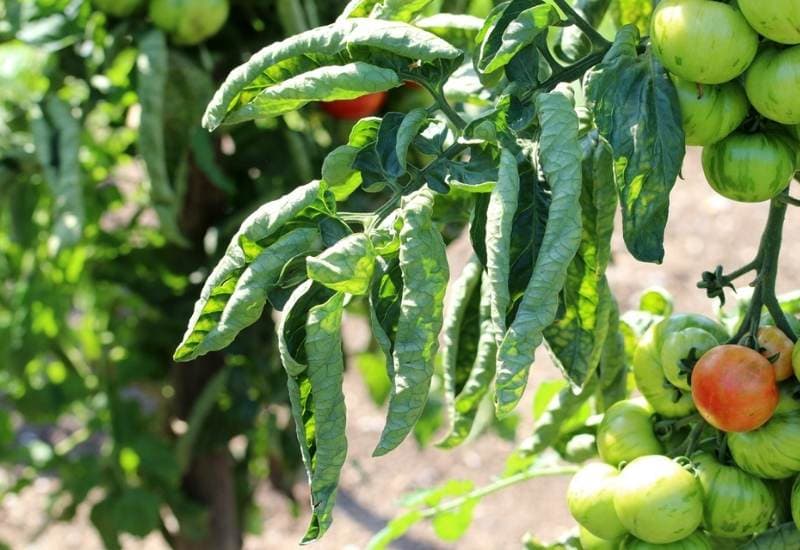
Depending on the root cause, you may or may not be able to treat leaf curl in your tomato plants. If the curling is just from stress, likely you can remedy the responsible factor and your plant may recover.
However, if the leaf curl is a symptom of a much deeper problem, your plant may be beyond saving.
To be 100% sure about the cause, you can clip a sample and send it in to your local horticultural research university, many of which can do a formal lab diagnosis.
Let’s address the causes one by one below, to see what can be done to help.
Environmental stressors
If you believe your tomato leaves are curling due to a stress in their environment, try and identify any recent weather or irrigation changes you have made.
Physiological leaf curl typically occurs after high heats and dry temperatures, so water your plants deeply at the root level and see if it makes a difference.
If you are in an area with high winds, try putting up a wind breaker- which could be in the form of other plants, a fence, or a tarp.
You can do a soil test and try to identify any lack of or excess of nutrients, and put a one inch layer of mulch around the base of your plants to help with moisture retention.
Herbicide residues
If you are dealing with herbicide residues in your soil, it will be hard to treat unless you move your tomato plant to a container filled with new soil.
Similarly, herbicides moving on the wind may be hard to prevent, but it’s worth discussing the issues they can cause with neighbors to try and reduce the likelihood they will enter your garden and curl your tomato’s leaves.
Depending on the severity, your tomato plants may make it through the season and still have a significant yield.
Viruses
Most of the viruses mentioned here are hard to conclusively identify until patterning has developed on the tomato leaves (like tomato mosaic virus), and this is usually once the virus is quite advanced and will have likely spread to other plants.
There are no cures for viruses, and the only thing to be done is try and identify them early and pull out infected plants, to try and save as many remaining crops as possible before it spreads.
Burn or throw away infected plants, don’t leave them on the ground or in the compost where they will continue to propagate.
Pests
If many leaves and fruits have been attacked by broad mites, the best solution may be to pull the plant. If you have discovered them early, you can use a horticultural oil like Neem oil or insecticidal soaps.
You can also introduce predatory mites (sold by many organic gardening companies) that will eat the broad mites.
Make sure to confirm that the issue is indeed broad mites and even then only use organic products.
Harsh chemicals can harm the tomato plant, and if the issue was misidentified as Broad mites, then other causes may be exacerbated by pesticide application.
Preventing Leaf Curl On Tomato Plants
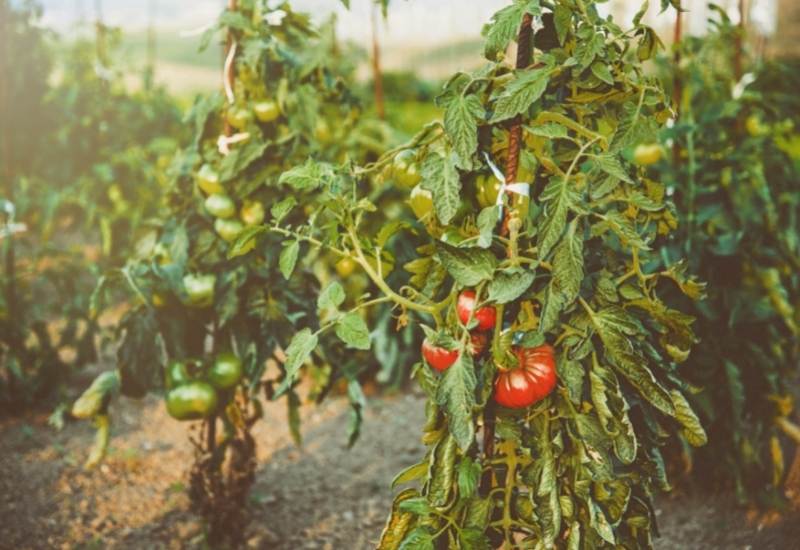
Healthy tomato plants will be less prone to leaf curl as they will be more resilient to adversity. So generally, make sure to keep your plant in good health with enough nutrients, water, and sunlight for it to thrive. Here are some more tips to keep in mind:
Sources
- Trinklein, D. (2019, July 3). Tomato leaf curl. Missouri Environment & Garden; University of Missouri. https://ipm.missouri.edu/MEG/2019/7/tomatoLeafCurl/
- Attia, A. (2020, September 3). Tomato Leaf Curl—Why Are My Tomato Plant Leaves Curling? DIYs.Com. Https://Www.Diys.Com/Tomato-Leaf-Curl/
- Masabni, J.; Anciso, J.; Wallace, Russel. (n.d). What Makes Tomato Leaves
- Twist or Curl? Texas A&M AgriLife Extension. E-626 12/12

Written By
Amber Noyes
Amber Noyes was born and raised in a suburban California town, San Mateo. She holds a master’s degree in horticulture from the University of California as well as a BS in Biology from the University of San Francisco. With experience working on an organic farm, water conservation research, farmers’ markets, and plant nursery, she understands what makes plants thrive and how we can better understand the connection between microclimate and plant health. When she’s not on the land, Amber loves informing people of new ideas/things related to gardening, especially organic gardening, houseplants, and growing plants in a small space.
